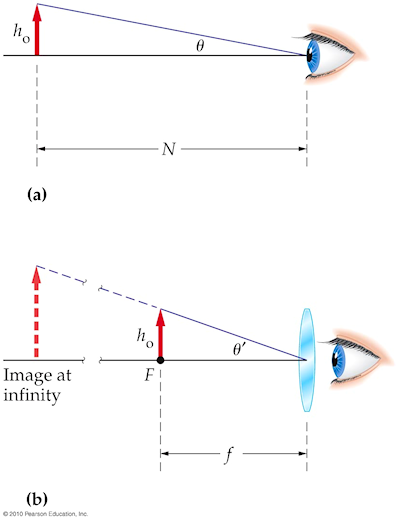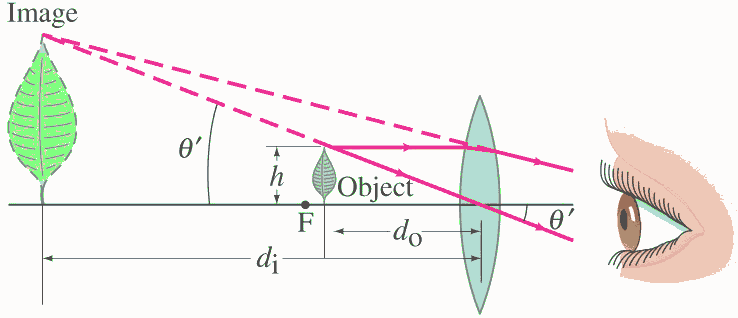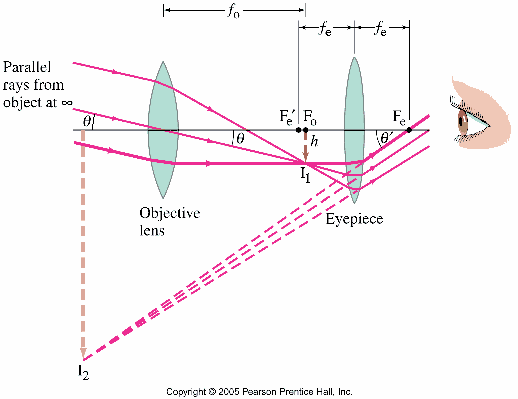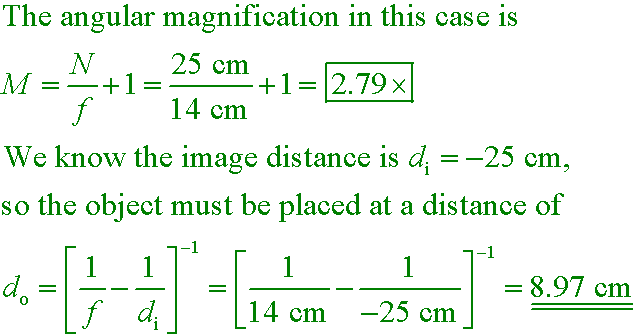Summary
- Thin lenses
- Dispersion & rainbows
- Human vision correction

- The magnifying glass applet

- The telescope

- The microscope
- Lecture learning outcomes
A student who masters the topics in this lecture will be able to:
- describe the difference between linear magnification and angular magnification
- distinguish between the angular magnification of a magnifying glass when the image is at infinity and when it is at the viewer's near point
- use algebra to find the angular magnification M, near point N, or focal length f for a magnifying glass when any two of these quantities are given
Practice:
Try these additional examples
Example #3
Example #4
Example #5
Prepare:
Read textbook sections 28-1 through 28-2 before the next lecture
gc6 25.22
What is the focal length of a 3.5× magnifier for a relaxed (focused at infinity) normal eye?
A. 14.0 cm
B. 7.14 cm
C. 4.00 cm
D. 28.6 cm
Answer
gc6 25.31
An 8.0× binocular has 2.8 cm focal length eyepieces. What is the focal length of the objective lenses?
A. 80.0 cm
B. 44.6 cm
C. 35.0 cm
D. 22.4 cm
Answer
Walker5e 27.48a
Two magnifying glasses are for sale at a store. Magnifying glass 1 has a 4-in. diameter with a long focal length, and glass 2 has a 1-in. diameter with a short focal length. Which one should you purchase if you wish to examine tiny insects?
A. magnifying glass 1
B. magnifying glass 2
C. either one
Answer
Walker5e 27.48b
Two magnifying glasses are for sale at a store. Magnifying glass 1 has a 4-in. diameter with a long focal length, and glass 2 has a 1-in. diameter with a short focal length. Which one should you purchase if you wish to start a campfire using sunlight?
A. magnifying glass 1
B. magnifying glass 2
C. either one
Answer
Walker5e 27.50b
A magnifying glass is a single convex lens with a focal length of ƒ = +14.0 cm. What is the angular magnification when this lens forms a (virtual) image at the person's near point (assumed to be 25 cm)?
A. 1.56×
B. 1.79×
C. 2.79×
D. 35.0×
Answer
B. 7.14 cm

D. 22.4 cm

A. magnifying glass 1
The angular magnification of a magnifying glass is inversely proportional to its focal length, so a shorter focal length means greater magnification and is better for examining tiny insects.
B. magnifying glass 2
The ability to start a fire with sunlight depends on how much light energy the lens can capture. A lens with a bigger area will capture more sunlight, hence the lens with the larger diameter is the better one for starting a campfire.
C. 2.79×






